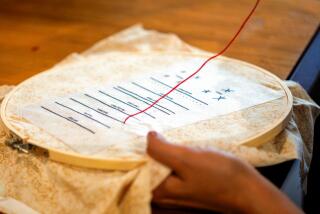Demand Is High as Old-Fashioned Patchwork Quilts Make a Comeback
MALDEN, W.Va. — Trying to earn a living with needle and thread, Charlotte Keim sewed rag dolls and Amish dolls at home for nearly a decade, and then sewed trousers for Sears, Roebuck and Co.
Now she is learning new methods of old-fashioned quilting, making patchwork quilts for the Lands’ End mail-order house as a new member of the Cabin Creek Quilts cooperative, based in this Kanawha River town about 10 miles east of Charleston.
“I’m really excited by the quilts because I know it’s something I can fall back on if I’m good at it, and I plan to be,” Keim said.
The co-op hopes to recruit and train 200 home sewers like Keim in the next year to take advantage of a pent-up demand for handmade American quilts.
Most of the estimated $2-billion market in quilts has gone to machine-made American and hand-stitched Chinese products, leaving handmade American work with only a 2% share of the market, according to experts.
This year American quilters became angry when the Smithsonian Institution licensed rights to reproduce 12 historic American quilts from its collection to a New York importer that contracted with factories in China.
The Smithsonian quilts are sold in department stores and through Spiegel catalogues for about $150, one-fourth the price of a handmade American quilt.
“We are giving away our heritage to the Chinese,” said Cecile Uhry of the Amoskeag Quilters Guild in Manchester, N.H. “If I had given a quilt to the Smithsonian, I’d ask for it back in a minute.”
The Smithsonian quickly agreed not to renew its three-year importing arrangement and struck a deal with Cabin Creek to reproduce a Smithsonian design.
Now, Cabin Creek Quilts is scrambling to complete its first two orders. But it needs more skilled sewers and quilters for the big orders of the future, said James Thibeault, director of the co-op.
Thibeault organized the Cabin Creek co-op in 1970 for Volunteers In Service To America to help poor Appalachian women turn a traditional skill into income.
Similar quilting cooperatives sprang up across the country during the 1960s and 1970s, jump-starting the international industry, Thibeault said.
But most of the American co-ops died because of competition from cheaper reproductions, and the few that remain are just hanging on. Cabin Creek’s members were about to give up last year, but Thibeault, who left in 1973, returned to revive the business.
“This was a project of the ‘War on Poverty’ and now it’s a survivor that has to struggle its way into the 21st Century,” he said.
Earlier this year, Cabin Creek met with Freedom Quilting Bee, a co-op quilt factory in rural Alabama that grew out of the civil rights movement, and Missouri Breaks, a co-op on Lakota Sioux reservations in South and North Dakota.
“They all said the same thing: ‘We cannot exist in this country with the import situation being what it is. We’re too far from the markets and we can’t afford to get to the markets,’ ” Thibeault said.
They agreed to collaborate on an “All American” quilt, featuring an American eagle and a peace pipe in a five-pointed star.
The eagle star is designed and made by Mary Ann Chasing Hawk Helper and her family, all members of Missouri Breaks.
The star is set into a background of the traditional Appalachian “log cabin” design made by Cabin Creek members, and Freedom Quilting Bee makes the “Broken Chains” pattern for the border.
Lands’ End, which has featured an Amish-made quilt in its November bed and bath catalogue for six years, had long sought other American sources. A customer put Lands’ End in touch with Cabin Creek just before the storm broke over the Smithsonian contract.
Lands’ End will feature the All American quilt in November and another pattern by Cabin Creek in its January bed-and-bath catalog.
Company officials said they would like to offer handmade American quilts several times a year.
Thibeault said the All American project has encouraged him to plan an “American Quilt Center” in a historic building across the road from Cabin Creek’s current home.
The center would provide training, equipment, and steady work to American quilters, while offering quality control and quantity reproductions of a single pattern to companies wholesale.
“Thibeault would like to be the central clearinghouse for anybody in the nation who’d like to quilt commercially. That’s a very powerful concept,” said Anita Iodice, product manager for Lands’ End.
“A lot of people have written and said, ‘We have a group of three who’d like to quilt for you.’ They could produce maybe two or three quilts a year on their own and we couldn’t utilize them,” she said.
Cabin Creek already is training members on a quilting machine. Thibeault hopes the co-op can use it to cut costs on patterns where the quilting isn’t prominent.
Even if machines start doing some of the labor, he thinks Cabin Creek could triple its membership and production in the next year, providing 200 new jobs for women in rural West Virginia.
The co-op is seeking state job training funds and money to purchase industrial sewing machines for home sewers. West Virginia officials hope the project will increase tourism, too.
“Once Cabin Creek Quilts start being marketed by Lands’ End, it’s going to be like L. L. Bean’s. People will get off the West Virginia Turnpike to go there,” said Bill Drennen, head of the state’s Division of Culture and History.
The need for home-based jobs is great, said Marie Cole, who is teaching Keim and 15 other women speed cutting and piecing for the Harvest Sun pattern. She and a team of students will make the quilt tops.
“This will be a steady income I can count on every month, whereas before I made pillow quilts and friends sold them for me,” Cole said. “Before Christmas I’d have a big boom, but other months I’d sell almost nothing.”
One of Cole’s students is a widow who used to work as a nurse’s aide, but can no longer be on her feet eight hours a day, Cole said.
Another is a college-educated woman whose husband lost his job around the same time her father had a stroke, Cole said. She can earn money at home while caring for her father.
Cindy Nutter, Cole’s niece, said she can care for her four young daughters at home while earning $400-600 a month for 40 to 60 hours of work.
Cabin Creek provides members with training, fabric, some tools, gasoline money to get to its classes, and lunch if necessary. Once they are ready to work, the co-op will ship fabric to them and pay them for each finished quilt top.
More to Read
The biggest entertainment stories
Get our big stories about Hollywood, film, television, music, arts, culture and more right in your inbox as soon as they publish.
You may occasionally receive promotional content from the Los Angeles Times.










